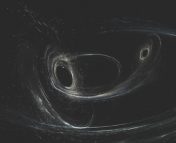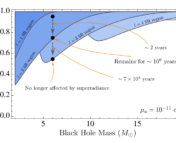Title: The Two LIGO/Virgo Binary Black Hole Mergers on 2019 August 28 Were Not Strongly Lensed
Authors: Leo P. Singer, Daniel A. Goldstein, and Joshua S. Bloom
Status: open access on arXiv
First Author’s Institution: Astroparticle Physics Laboratory, NASA Goddard Space Flight Center, USA
To the elation of gravitational wave hunters everywhere, the LIGO/Virgo collaborations went public in April of this year. This means that live alerts are sent out when their detectors find something significant. As a result, other teams with telescopes that are sensitive to different types of radiation can point their antennae in the direction of the gravitational radiation. If something luminous was involved in the gravitational wave production, then they’ll hope to see any radiation given off at other frequencies, like x-rays, or radio waves.
This is how the first confirmed neutron-star merger was detected. LIGO/Virgo picked up the gravitational wave signal, and then a number of facilities, including the NASA Fermi telescope and the Dark Energy Survey, confirmed the detection in all ranges of the electromagnetic spectrum. This led to tonnes of exciting science which you can read about here, here and here.
Today’s paper focuses on an unusual alert from LIGO/Virgo. It was a detection of black holes merging, so there was no electromagnetic counterpart to be found (although this might not always be true…) However, the thing that caught today’s author’s eyes was that there was not one, but two merger events within 20 minutes of each other, and seemingly from similar places in the sky.
Why is this weird?
Given the amount of sky that LIGO/Virgo is able to detect signals from, observing independent black hole mergers within 20 minutes of each other should only happen roughly once every 16 years. That’s pretty small odds… which got people thinking. Given that these two signals also seemed to originate from very similar patches of the sky (although they’re not able to localise the signal amazingly without an electromagnetic counterpart), could this actually just have been one black hole merger which had been gravitationally lensed and then detected twice?!
Magnifying gravity – say whut?
In order to get to us from wherever the violent process which produced the gravitational waves started, the gravitational waves have to pass through all sorts of structures like stars, galaxies and galaxy clusters. Each of those structures will cause space-time to curve due to gravity; the more massive the object, the more the space-time is curved. If a gravitational wave, or any type of radiation, passes through that region of space-time, it’ll take longer to reach us traveling along the curved path. This means that we’re likely to detect multiple signals at slightly different times, caused by the gravitational waves taking slightly different paths through the curved space-time on their way to us.
Figure 1: The localisations of the two signals on the sky. The first signal in blue, the second in orange and the joint product in black (the localisation expected if it was just one merger that was lensed). The regions represent 90% credible localisations. The faint mirror images in the background of the sphere are 180 degrees offset from the main coloured regions, because LIGO/Virgo can’t determine whether a signal came from directly above or below the detectors.
Today’s authors investigate whether two black holes were at play here, or four. Based on the localisations (see figure 1) of the signals, they run a set of simulations to work out the most likely angular separation on the sky between the two signals. They find that there is a greater than 99.99% chance that the separation between the two signals is larger than 1 degree on the sky. However, for such a large separation, you’d expect to need an absolutely humongous object to be doing the lensing. Even galaxy clusters as large as 1015 solar masses would only produce a typical separation of around one arcminute. Furthermore, the time delay between the two signals that you’d expect from cluster-sized lenses would be more like several decades rather than several minutes!
So, if this was just one black hole merger event, there needs to be a monstrous object hiding somewhere that we are yet to discover, and we also need the black holes and the lens to have been in a particular alignment so that the time delay is much smaller than would normally be predicted for such a large lens.
Despite the fact that it was super unlikely for two mergers to be detected within 20 minutes of each other, today’s authors argue that the other possible explanation is even more unlikely. It looks as though it was indeed just a spooky cosmological coincidence.




